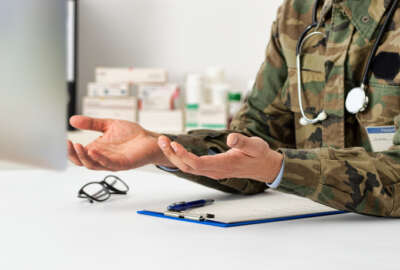Air Force turning to AI for better fitness, injury prevention
The program focuses on balance as a way of determining health.
Musculoskeletal injuries are the primary source for disability in the military and account for 2.4 million health care visits each year. That can add up to be a serious readiness issue for the services.
The Air National Guard is especially looking for ways to reduce physical injury and make training less strenuous on joints, bones and ligaments.
“We’re always carrying heavy rucksacks that could weigh anywhere from 70 pounds upwards of 120 pounds,” Chief Master Sgt. Jeremy Mullins, enlisted supervisor for the 118th Air Support Operations Squadron. “We do things like jumping out of planes and fast roping out of helicopters, so we have a lot of ankle and leg injuries from those types of activities and lower back injuries because we’re carrying a heavy load.”
The Air Force is now trying to work smarter by learning ways to better distribute weight, wear equipment and workout to avoid injury. Many units are embedding physical trainers to keep an eye on health.
The 118th Air Support Operations Squadron is teaming up with a firm focused on using data for health called Sparta Science.
The company uses sensors and best practices to help inform airmen about how they should workout that day and can even help indicate if an airman is injured.
“When Sparta first started, we asked ‘What are some of the things that consistently relate to both injury and performance?’ And what we came down to is what’s called ground reaction force, how you interact with the ground,” said Dr. Phil Wagner, founder of Sparta Science. “That’s measured by a force plate. The plates are a little bit bigger than a bathroom scale. It gathers millions of data points in a minute. And that minute can be a jump or that minute can be balanced test. Then all those data points can feed into a machine learning platform.”
The program takes into account sex, age, weight and other factors and creates a profile for that airman on that day to preform optimally and reduce injury.
“It’s definitely helped on the injury prevention side,” Mullins said. “I haven’t seen nearly as much in terms of low back injury and definitely not as much pain.”
The program can also track for traumatic brain injuries, an area where the military is putting particular focus.
By judging how a person is balancing the program and force plate can take note of an airman who may be off kilter. Those lilts can often be signs of head injury.
“It’s a helpful tool because now leadership knows there’s a traumatic brain injury,” Mullins said. “They can say, ‘Hey, we need to sideline this guy for a little bit.’ That helps with our overall readiness as well, and truly trying to know some of our folks.”
Copyright © 2024 Federal News Network. All rights reserved. This website is not intended for users located within the European Economic Area.
Scott Maucione is a defense reporter for Federal News Network and reports on human capital, workforce and the Defense Department at-large.
Follow @smaucioneWFED






